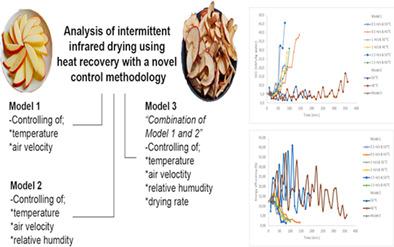当前位置:
X-MOL 学术
›
J. Food Process Eng.
›
论文详情
Our official English website, www.x-mol.net, welcomes your feedback! (Note: you will need to create a separate account there.)
Analysis of intermittent infrared drying using heat recovery with a novel control methodology
Journal of Food Process Engineering ( IF 3 ) Pub Date : 2020-07-19 , DOI: 10.1111/jfpe.13491 Ekin Can Dolgun 1, 2 , Gülşah Karaca 1, 3 , Mustafa Aktaş 4 , Faruk Kılıç 5
Journal of Food Process Engineering ( IF 3 ) Pub Date : 2020-07-19 , DOI: 10.1111/jfpe.13491 Ekin Can Dolgun 1, 2 , Gülşah Karaca 1, 3 , Mustafa Aktaş 4 , Faruk Kılıç 5
Affiliation

|
Drying is one of the most energy consuming process. By using automatic control systems in the industry, a higher quality and energy efficient drying is achieved. There are two main periods in drying process, the constant rate period and the falling rate period. In the falling rate period, it becomes difficult to evaporate water from the product, and this results in high specific energy consumption values and low energy efficiency values. In this study, apple slices were dried in an intermittent infrared dryer with two new developed drying methodologies as a solution to this problem (Model 2 and 3). An Arduino based automatic control system was used for Model 2 and Model 3. Developed models were compared with conventional experiments (Model 1). With Model 2, a constant drying rate was achieved independently of the moisture content. With Model 3, 57% shorter drying time compared to Model 2 and 16% less energy consumption compared to Model 1 was provided. Also using of the Model 3 the energy efficiency increased as 50% and the specific energy consumption decreased as 48% compared to Model 1. This study offers a solution with high efficiency in industrial usage.
中文翻译:

新型控制方法利用热量回收进行间歇性红外干燥分析
干燥是最耗能的过程之一。通过在工业中使用自动控制系统,可以实现更高质量和更高能效的干燥。干燥过程中有两个主要时期,恒定速率时期和下降速率时期。在下降速率期间,变得难以从产品中蒸发水,这导致较高的单位能量消耗值和较低的能量效率值。在这项研究中,苹果片在间歇式红外干燥机中用两种新开发的干燥方法进行干燥,以解决该问题(模型2和3)。将基于Arduino的自动控制系统用于模型2和模型3。将开发的模型与常规实验(模型1)进行了比较。使用Model 2,可以获得恒定的干燥速率,而与水分含量无关。使用Model 3,与模型2相比,干燥时间缩短了57%,与模型1相比,能耗降低了16%。与模型1相比,还使用模型3时,能效提高了50%,单位能耗降低了48%。这项研究为工业使用提供了一种高效解决方案。
更新日期:2020-07-19
中文翻译:

新型控制方法利用热量回收进行间歇性红外干燥分析
干燥是最耗能的过程之一。通过在工业中使用自动控制系统,可以实现更高质量和更高能效的干燥。干燥过程中有两个主要时期,恒定速率时期和下降速率时期。在下降速率期间,变得难以从产品中蒸发水,这导致较高的单位能量消耗值和较低的能量效率值。在这项研究中,苹果片在间歇式红外干燥机中用两种新开发的干燥方法进行干燥,以解决该问题(模型2和3)。将基于Arduino的自动控制系统用于模型2和模型3。将开发的模型与常规实验(模型1)进行了比较。使用Model 2,可以获得恒定的干燥速率,而与水分含量无关。使用Model 3,与模型2相比,干燥时间缩短了57%,与模型1相比,能耗降低了16%。与模型1相比,还使用模型3时,能效提高了50%,单位能耗降低了48%。这项研究为工业使用提供了一种高效解决方案。



























 京公网安备 11010802027423号
京公网安备 11010802027423号